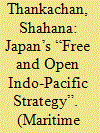| Srl | Item |
| 1 |
ID:
157809


|
|
|
|
|
| Summary/Abstract |
Japan’s “Free and Open Indo-Pacific Strategy” was announced as recently as November 2016. However, it may be argued that Japan has been acting in accordance with this principle for over a decade in the Indo-Pacific region. While the Asia–Africa Growth Corridor and the “quadrilateral” initiative could be called the latest and more visible manifestations of this strategy, they are definitely not the first. This paper explores two core elements of the Free and Open Indo-Pacific Strategy, namel, regional connectivity and proactive contribution to peace, and highlights Japan’s initiatives in this regard in the Indo-Pacific.
|
|
|
|
|
|
|
|
|
|
|
|
|
|
|
|
| 2 |
ID:
192909


|
|
|
|
|
| Summary/Abstract |
The India-Japan mutuality has been acquiring steady salience through the 21st
century, exuded in no small measure in the telegenic flourish of the
nomenclatures, connoting engagement.1
Since late Prime Minister Abe Shinzo’s
clairvoyant averment of the ‘Confluence-of-the-Two-Seas’ schema in 2007,2
through to incumbent Prime Minister Kishida Fumio’s recent seminal unveiling
of the Indo-Pacific Vision, the purposeful choice of India as a venue for such
defining articulations, is emblematic of Tokyo’s convictions about New Delhi
as the veritable ‘indispensable partner’ across the trans-regional straddle, and
in its extremities.3 However, whilst iconic infrastructure-built projects embody
resplendent mutual equations, the visage of India-Japan cooperation and
convergence across third countries, and extant sub-regions, remains heady
in promise and teeming with possibilities; yet, in reality, is only incremental,
and substantively underwhelming in performance. This ‘expectationsoutcomes’ disconnect is all the more galling when contextualised in both the
protagonists’ deeply shared apprehensions over the coercive and predatory
dimensions of Chinese strategic ascendancy. Both countries have espoused
the need for a plural rules-based maritime order, and the chaperoning of a
mercantilist and infrastructure development edifice which is anchored-in
political transparency, financial rectitude, social consultation, and ecologically
congruent actions, in the Indo-Pacific.4
|
|
|
|
|
|
|
|
|
|
|
|
|
|
|
|